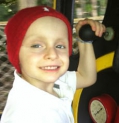Exploiting the Potential of Bromodomain Inhibitors in Ewing Sarcoma

Project Goal:
Project Update 2024:
My work is aimed at identifying new combination therapeutic strategies for patients with Ewing sarcoma (EwS), an aggressive bone and soft tissue tumor affecting adolescents and young adults (AYA). Specifically, I am investigating how we can effectively use a class of drugs known as bromodomain and extraterminal domain protein (BET) inhibitors. These drugs aim to alter the expression of genes that are critical for EwS cancer cell survival and growth, subsequently leading to cell death. We know that using one drug will not be sufficient to kill all tumor cells so my efforts are focused on identifying additional treatment strategies we can use with BET inhibitors to improve the efficacy of killing tumor cells. Through deep gene expression profiling, phenotypic profiling, and an unbiased drug screen I have discovered that while cells that escape BET inhibition are more invasive and dependent on a protein called focal adhesion kinase (FAK). FAK is a protein that is critical to tumor cell survival, growth, and migration, and has previously been described to be important for EwS tumor cell growth. There are drugs that target FAK, and we are studying the drug Defactinib- a FAK inhibitor in combination with the BET inhibitor. Our studies have identified that the combination of BET and FAK inhibition is synergistic in our lab models, and preliminary results from our animal experiments reveal that it is synergistic in our animal models as well. We are in the process of validating these findings in our animal models, and are hopeful that if we see promising results, that we will propose this combination drug strategy for clinical trial. Additionally, we remain focused on understanding additional ways by which EwS tumor cells escape BET inhibition. One additional hypothesis that we have is that this is occurring through changes in the epigenome, and plan to perform upcoming studies that will look at the changes that occur at this level.
Final Project Update 2025:
My project aims to understand how EwS cells evade the effects of BET inhibitors and to identify additional therapeutic strategies that can enhance their efficacy. Using two unbiased approaches—a drug screen and deep gene expression profiling—we discovered significant differences in the cells that survive prolonged BET inhibitor treatment. We found that these surviving tumor cells exhibited changes in how they interact with their surrounding microenvironment. Notably, we identified that these cells became reliant on a protein called Focal Adhesion Kinase (FAK), which plays a key role in signaling between the tumor cells and their microenvironment, contributing to tumor cell survival, growth, and invasion. In particular, there is a clinical grade drug that targets FAK, called Defactinib. Dual targeting of FAK inhibition with BET inhibition blocks growth and invasion in lab models leading to enhanced tumor cell death. Further, this combination in animal models slows the progression of bulky disease, and in a metastatic model prevents tumor cell formation and outgrowth. Our studies demonstrate that EwS tumor cells evade the effects of BET inhibitors by upregulating a protein called FAK, which can be effectively targeted with Defactinib to enhance the efficacy of BET inhibitors.

